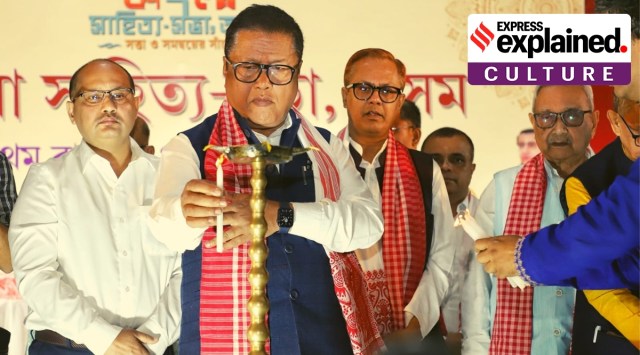Earlier this week, a scarf became the site of controversy in Assam. A newly formed Bangla Sahitya Sabha Assam (BSSA) used a hybrid creation — an Assamese gamosa and a Bengali gamcha, each cut in half and sewn together — to felicitate guests at a function on Sunday (March 26), and this did not go down well with a section of Assamese society.
Protests broke out in different parts of the state, particularly by Assam nationalist organisations and student groups, claiming that this creation was an insult to the Assamese gamosa. Subsequently, the BSSA had to issue an apology for “hurting anyone’s sentiments unintentionally”.

Symbolic value of a scarf
One half of the controversial scarf was a red-and-white floral Assamese gamosa, or a phulam gamosa, and the other half was a red-and-white chequered pattern gamcha, used by Bengalis. In its apology statement, the BSSA stated that the idea behind this creation was “symbolic harmony”.
However, this backfired, simply because there is a fundamental difference in the nature of the two garments which had been stitched together, and equating the two touched a raw nerve.
The phulam gamosa is steeped in emotive weight and is considered to be a symbol of Assamese cultural identity.
According to Sunil Pawan Baruah, retired professor of history, the reverence associated with the gamosa extends in multiple directions.
“It has a deep symbolic value in Assam, be it religiously, socially or culturally. Socially, it is gifted as a symbol of mutual respect and solidarity. It also has a special relationship with the Vaishnavite culture in Assam. The axon, the main place of worship, is considered incomplete without one. So there’s a lot of emotion attached to it,” he said.
Story continues below this ad
During moments when Assamese sub-nationalism took centre stage — the Assam Agitation of the early 1980s and more recently, the anti-Citizenship Amendment Act protests in the state — the gamosa was prominently used by protesters as a marker of Assamese identity.
On the other hand, the Bengali gamcha does not have such symbolism attached to it and is a utilitarian item for household use.
Professor Baruah points out that a completely different garment — a long scarf called an uttariya — is used in cultural programmes and to welcome guests in Bengali society.
Politics and anxieties
Below the surface of this issue, simmer long-standing anxieties and a pushback to what some see as attempted cultural homogenisation for political ends.
Story continues below this ad
According to Joydeep Biswas, who teaches at Cachar College, Silchar, the BSSA reflects this attempt at cultural homogenisation.
“Since 2016, politics in Assam has changed with the BJP’s plank of otherising Muslims. There is a push for an alliance between Bengali Hindus and Assamese Hindus to consolidate these votes — this has served them well in the last two elections in the state. The leadership of the particular Sahitya Sabha comprises only Bengali Hindus and some of them are known to write provocatively on Hindutva lines. For them Bengalis mean Bengali Hindus,” he said.
Ex-BJP MLA and chairperson of the Assam Linguistic Minority Development Board, Shiladitya Dev, is the chief patron of the literary society, adding to this perception.
But the attempted symbolism of oneness has been met by opposition from Assamese ethnic-nationalism, where it is being viewed as “dilution”.
Story continues below this ad
“The gamosa has a national identity. People have strong emotions towards it, they respect and honour it. It has its own distinct identity and that was sought to be diluted. Things that are a part of folk culture can’t be diluted, especially after the gamosa has received a GI tag,” said Lurinjyoti Gogoi, former general secretary of the All Assam Students’ Union and president of the Assam Jatiya Parishad (AJP), a regional party born out of the anti-CAA protests.
“If ‘harmony’ is the issue, there are many more fundamental things to be addressed first, like the constant politics of hatred and divisiveness,” he added.
Biswas also adds that the backlash might not have been this strong if it would have been some community other than Bengali.
“Assamese society and nationalist organisation are sensitive on matters related to Bengalis and there is a big trust deficit. This is because historically there has been a paranoia about Bengali hegemony, right from the 19th century when the Bengali was made the state language by the colonial state. So now, there’s a counter-hegemony, though the trust deficit has decreased a lot since the days of the Assam Agitation, with the passage of time and also, to some extent, the BJP’s work of homogenisation,” he said.








































